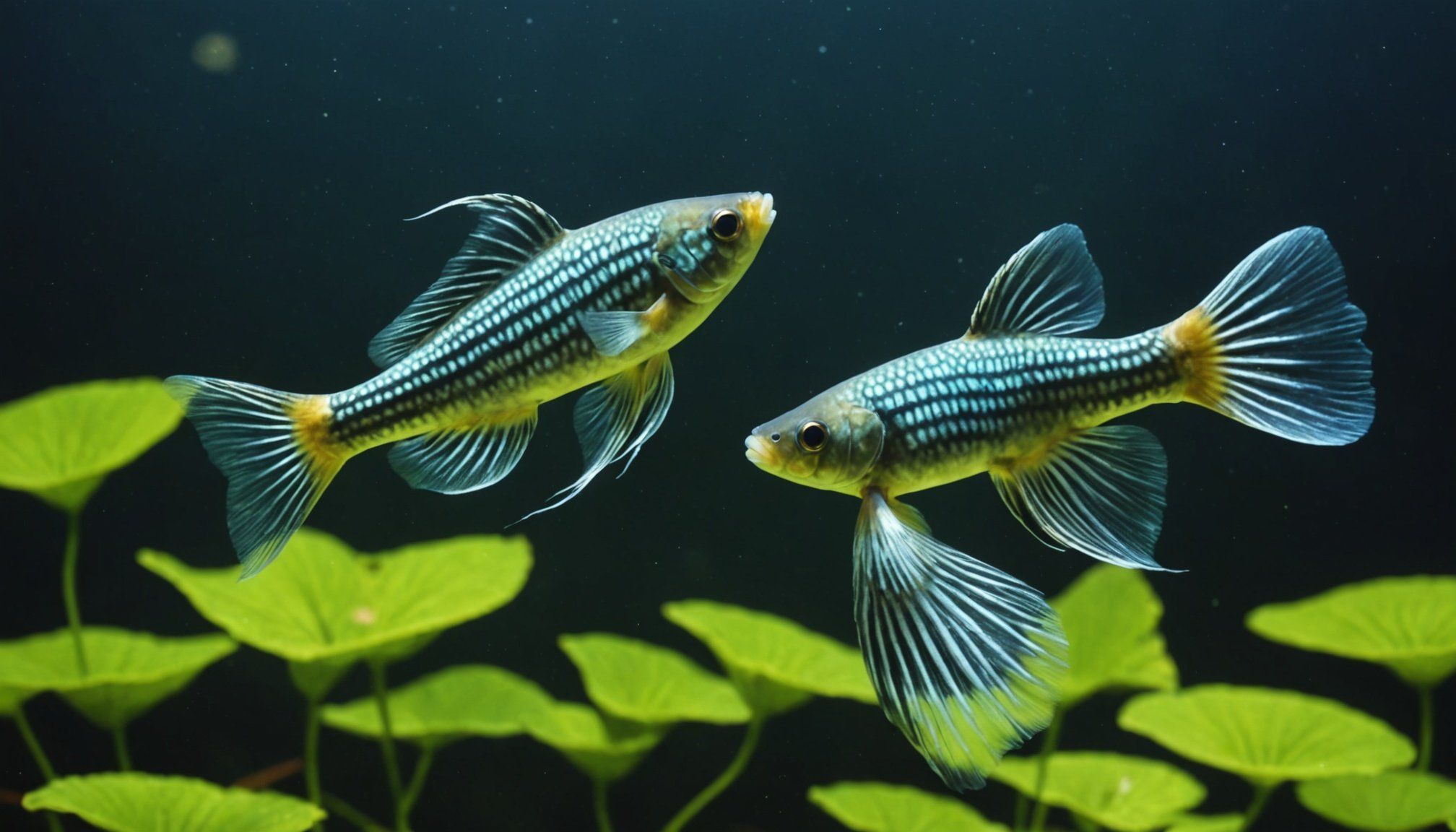Understanding Guppy Genetics
Guppy genetics can seem complex, but understanding inherited traits is crucial for successful breeding. Guppies exhibit a wide array of color variations and patterns, primarily due to genetic diversity. The most common variations include vibrant oranges, blues, and the striking mosaic patterns.
These genetic traits are inherited through dominant and recessive genes. For instance, the dominant gene might control common color features like a bold orange, while recessive genes can introduce more subtle and unique patterns. Selective breeding allows enthusiasts to cultivate these traits intentionally.
Also read : Top Tips to Reduce Shedding in Double-Coated Dogs: Expert Solutions for a Cleaner Home
In crafting a strategic breeding plan for desired traits, one must carefully select breeding pairs. This selection should focus on both the visual appeal of the guppies and their genetic lineage. Strategic breeding helps optimize the desired variations and ensures the propagation of preferred characteristics in future generations.
Careful record-keeping during breeding is also beneficial. It allows breeders to track genetic outcomes and tweak breeding strategies as necessary. This meticulous attention to genetic detail is essential in crafting guppies that stand out for their beauty and uniqueness. Such strategies not only enhance aesthetic qualities but also contribute to healthier, more resilient guppies in the long run.
Also read : Train Your Pooch to Master Household Duties: An Entertaining Guide to Dog Chores
Setting Up the Breeding Tank
Establishing the ideal breeding tank setup is crucial for the success of guppy breeding. To begin with, the tank size should be at least 10 gallons to provide sufficient space for the breeding pairs and the eventual fry. An adequate size ensures minimal stress and promotes better health and breeding conditions.
Water parameters are equally vital. The pH should be maintained between 7.0 and 7.8, with temperatures around 76°F to 82°F. It’s important to keep the water hardness between 8 and 12 dGH, ensuring an environment that mimics their natural habitat. These parameters play a pivotal role in enhancing breeding success.
Ensuring optimal water quality requires essential equipment like filters and heaters. A high-quality filter maintains cleanliness, while a reliable heater provides stable water temperature. Decorations can be added to offer hiding places, ensuring comfort and reducing stress.
Regular monitoring and maintenance of the breeding tank setup, including routine checks of the water parameters, are essential. This meticulous attention to environment details helps in creating an ideal breeding setting, ensuring the well-being and successful reproduction of your guppies.
Preparing Guppies for Breeding
Ensuring readiness is crucial in preparing guppies for successful breeding. First, accurately identifying breeding pairs requires understanding gender distinctions. Male guppies are generally smaller and more colourful, showcasing vibrant hues like oranges and blues. Females tend to be larger, with a subtler colour palette. This knowledge is pivotal in selecting potential breeding pairs.
Once the pairs are identified, conducting thorough health checks becomes essential. Healthy guppies exhibit fins without damage and scales free of spots or discoloration. Their movement should be lively, indicating overall good health. Poor health can impact breeding success significantly, emphasising the importance of these checks.
Timing the introduction of these pairs in the breeding tank involves strategic planning. Optimal conditions in the breeding environment should already be established, including the right water parameters and tank setup as previously discussed. Introducing the pairs under conditions mirroring their natural habitats enhances the likelihood of successful breeding.
Monitoring the pairs after introduction can provide insights into their compatibility. If the male exhibits a courtship display, such as flaring fins, it’s a positive sign. Ensuring all these steps can significantly elevate breeding success, leading to healthier and more robust offspring.
Feeding During the Breeding Process
To promote breeding success, ensure guppies receive sufficient nutrition. Properly catering to their dietary needs can significantly improve fertility. Start by incorporating a varied breeding diet, which includes both live food and fortified supplements, to enrich guppies’ health.
Live foods like brine shrimp, daphnia, and bloodworms not only enhance color vibrancy but also provide essential nutrients that support successful reproduction. These dietary enhancements align closely with the guppies’ natural feeding habits, resulting in increased vitality and improved chances of breeding.
Feeding frequency is crucial in delivering optimal nutrition. Nutrition should be offered in appropriate portion sizes twice daily, ensuring guppies are well-nourished without overfeeding. Precise feeding routines prevent waste accumulation in the tank, which can alter water parameters and stress the breeders. Care maintains a healthy environment, vital for optimal reproduction conditions.
Incorporating supplemental feeds, such as enriched flakes or granules, can provide additional vitamins and minerals necessary for guppy health. With these breeding strategies, guppies are better equipped to spawn successfully, resulting in robust offspring. This approach not only supports breeding success but also grows healthier, more vibrant guppies overall.
Caring for Guppy Fry
Ensuring the proper care of guppy fry is crucial for their survival and development. Understanding their various growth stages helps in tailoring the care they require at each phase. Initially, fry are incredibly tiny and vulnerable, requiring a secure environment to thrive. This stage necessitates specific tank setup adjustments to promote safety and stability.
Essential Tank Setup for Fry
Setting up a separate, specially designed tank for guinea fry can significantly increase their survival rates. Key elements include:
- A gentle filter system to maintain water clarity without risking the fry being sucked in
- Maintaining optimal water parameters, such as a stable temperature between 78°F and 80°F
- Aquatic plants or fine-leaved structures to offer necessary hiding places for fry security
Nutritional Needs and Feeding Schedules
The dietary needs of guppy fry differ from adults; they require nutrient-rich, easily digestible food. Infusoria or powdered fry food should be administered multiple times daily in small portions to avoid waste build-up. As they grow, incorporating finely crushed flakes or brine shrimp aligns with their evolving nutritional needs. Maintaining a regular feeding schedule supports their health and fosters robust growth, ensuring they transition smoothly through their developmental stages.
Troubleshooting Common Breeding Issues
Breeding guppies often presents challenges, but understanding common breeding problems can aid in overcoming them. Recognizing signs of disease, such as odd swimming behaviour or discoloured scales, is critical. To manage disease risks, maintain excellent water quality and quarantine affected fish to prevent outbreaks. Regular health checks prevent issues before they escalate.
Frequent obstacles include poor fry survival and infertility. Increase fry survival rates by ensuring optimal water conditions and providing safe environments. Fry are sensitive to water quality changes, emphasizing the importance of stable parameters. Using gentle filtration systems and providing ample hiding spaces can further enhance their comfort and security.
Addressing infertility involves revisiting breeding strategies. Investigate whether environmental factors like temperature and lighting might impact reproduction. Moreover, nutrition plays a pivotal role in success. Ensure breeders receive a well-rounded diet rich in essential nutrients.
For specific concerns or ongoing issues, seek insights from experienced breeders. Engaging in online forums or local clubs can provide additional support. Leveraging the experience of others can supply you with unique solutions tailored to specific challenges, ensuring your own breeding efforts are both productive and fulfilling.
Expert Insights and Case Studies
Gaining insights from professional guppy breeders can significantly enhance your breeding strategies. Interviews with experts often reveal nuanced techniques that contribute to breeding success. For instance, some breeders have perfected selective breeding, resulting in unique color variations and robust health in their guppies.
Case studies of successful breeding practices provide real-world examples of overcoming challenges. One notable example involved a breeder facing persistent issues with fry survival rates. By meticulously adjusting water parameters and implementing novel breeding strategies, they achieved an impressive increase in fry viability.
Learning from these experiences can offer invaluable benefits. For example, paying attention to genetics helps harness specific genetic traits. Breeders focusing on these aspects cultivate guppies with customised color patterns and resilient health profiles.
Lessons learned through these stories underscore the importance of adaptability and precision in breeding. They highlight that understanding guppy genetics is essential for achieving desired outcomes. This approach ensures healthier, vibrant guppies meeting specific breeding goals. By incorporating these insights, breeders can not only solve common issues but also innovate new methods for breeding excellence.
Resources and Visual Aids
Engaging with breeding resources can significantly bolster your understanding of guppy genetics and breeding strategies. Consider exploring a variety of materials to deepen your knowledge. Recommended readings include books like “Guppies: Fancy Strains and Colour Mutations” which delves into extensive genetic traits and guppy color variation.
Visual aids are invaluable for comprehending complex processes. Diagrams illustrating breeding tank setups can serve as a practical guide. These diagrams help visualize essential components, ensuring tanks meet critical requirements such as appropriate tank size and optimal water parameters for successful breeding.
In addition, incorporating multimedia resources like instructional videos provides dynamic learning opportunities. For example, video tutorials on strategic breeding strategies and fry care can demonstrate techniques in action. Such resources are particularly effective for visually understanding how to maintain breeding tank setup and nurture fry care.
Seek diverse resources and consult online forums or platforms where breeders exchange advice and share experiences. These insights can illuminate advanced tactics, enhancing your overall breeding efforts. By integrating a combination of texts and visual tools, you can develop a comprehensive approach to guppy breeding success.
Frequently Asked Questions
Breeders often pose questions about guppy breeding to ensure optimal results. A frequent inquiry is, “What strategies improve fry survival?” The key lies in maintaining stable water parameters and creating a secure tank environment. Fry are highly sensitive to conditions, so gentle filtration and abundant hiding spaces are crucial.
Another common question pertains to managing breeding problems like infertility. Breeding success can be hindered by factors such as poor nutrition or incorrect environmental settings. Providing a varied, nutrient-rich diet and adjusting temperature and lighting can enhance reproductive outcomes.
Concerns about disease management often arise. Symptoms like irregular swimming or discoloured scales indicate potential health issues. Quarantine affected fish and uphold rigorous tank cleanliness to minimize disease spread. Regular health observations are essential for early detection and intervention.
For those seeking more specific advice, online forums and local guppy clubs offer a wealth of community-sourced knowledge. Engaging with experienced breeders can provide tailored solutions and guidance. By exploring these resources, you can effectively troubleshoot and refine your breeding techniques, fostering a more rewarding breeding experience.









